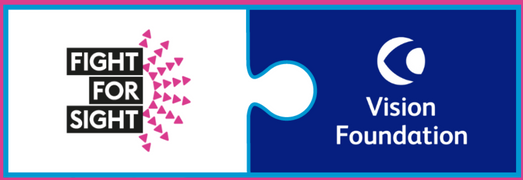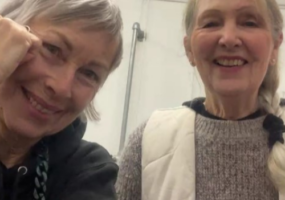February 29 is Rare Disease Day. This event aims to raise awareness and to generate change for the 300 million people worldwide living with a rare disease and their families and carers.
What is a rare disease?
A rare disease affects fewer than 0.050% of the population or 1 in 2,000 people, meaning that in the UK one in 17 people will be affected by a rare disease at some point in their life. There are currently over 7,000 rare diseases, a number that is set to increase as research discovers more.
Research has increased understanding and led to consequent breakthroughs for rare diseases but there is still no treatment for approx. 95% of them, which is why one of the themes for the UK Rare Diseases Framework is pioneering research.
It is for reason that the merger between Vision Foundation and Fight for Sight is so important. Together, we will combine breakthrough research and life-changing services to build a better world for blind and partially sighted people.
Let’s explore how Fight for Sight’s funding advances research into 5 rare diseases that cause sight loss.
Inherited retinopathies (caused by mutations in the CRB1 gene)
Inherited retinopathies are a group of eye diseases that affect the retina, the light-sensitive tissue at the back of the eye. They are all caused by at least one gene that is not working properly. In people with inherited retinopathies, the light-sensing cells (photoreceptors) in the retina stop working and eventually die – causing progressive sight loss, often leading to blindness.
Faults in the CRB1 gene can cause different inherited retinopathies. It is not understood why specific faults in this gene can cause different retinopathies with such varied patterns of sight loss – meaning healthcare professionals cannot predict the severity or how quickly a person’s sight loss will progress.
Professor Mariya Moosajee at the UCL Institute of Ophthalmology aims to improve our understanding of inherited retinopathies’ natural history (or progression) caused by faults in the CRB1 gene. Fight for Sight are co-funding her research alongside Moorfields Eye Charity. Her research could help determine which patients might benefit from novel gene therapies and other innovative treatments in the future.
Read more about research into CRB1.
Stargardt’s Disease
Stargardt’s Disease causes progressive central sight loss due to damage to the macula, which is located in the retina. This area of the eye is sensitive to light and contains photoreceptors that capture light and convert it into electrical signals. The brain then receives and interprets these signals into what you see.
Symptoms of the condition generally start in childhood and adolescence and will gradually worsen over time, although symptoms vary from person to person, for some sight loss might not occur until adulthood.
Stargardt’s is a genetic condition caused by faults in a gene containing instructions for cells to make a protein that removes toxic by-products from photoreceptor cells. Gene therapy provides an opportunity to prevent sight loss by delivering a correct copy of the faulty gene into the affected photoreceptor cells and restoring the process of toxic by-product removal.
This therapeutic approach has shown some success in clinical trials but not in the case of Stargardt’s Disease. This is due to the size of the faulty gene. It is for this reason we are funding research by Professor Omar Mahroo and Dr Matteo Rizzi at UCL who have developed a modified tool that can carry larger genes, specifically based on the faulty gene in Stargardt Disease.
If successful, this could pave the way for new gene therapies for many other inherited retinal conditions.
Find out more about this research.
Retinitis Pigmentosa
The leading cause of sight loss in children and working age adults are inherited retinal dystrophies (IRDs), such as Retinitis Pigmentosa (a group of rare eye diseases that affect the retina).
IRDs which cause untreatable blindness are caused by mutations in over 150 genes that result in the death of photoreceptors at the back of eye. Research has found gene therapy, mentioned above, may potentially be used to treat IRDs, such as Retinitis Pigmentosa.
At present there is only one form of gene therapy available for one rare eye condition. Results have shown that visual improvement is currently minimal and short lived. But there is still a need for understanding the cause of photoreceptor death, and treatment that can be used in combination or alongside gene therapies.
Fight for Sight recently awarded funding to a project by Dr Roly Megaw at University of Edinburgh that aims to investigate the processes that lead to photoreceptor death and consequently IRDs. If Dr Megaw’s team identify the pathway that leads to photoreceptor loss and identify a drug to stop it, this would represent a profound step towards the development of novel treatment for IRDs.
Find out more about the project.
Leber Hereditary Optic Neuropathy
Leber Hereditary Optic Neuropathy (LHON) is a genetic condition that that affects the optic nerve (which sends visual information to the brain) and causes sudden loss of central vision in both eyes.
LHON affects young adult men more than women and can begin in one eye or both simultaneously. Over time vision gradually worsens with a loss of sharpness and colour vision, which can impact people’s ability to perform detail-oriented tasks such as reading and driving.
Four genes have been linked with LHON, these genes interfere with how much energy mitochondria (the powerhouse of the cell) can generate. This then leads to the loss of nerve cells in the retina and the eventual deterioration of the optic nerve. Vision can sometimes be recovered, which suggests that these nerves are ‘sleeping’ as opposed to ‘lost’ and may be revived.
We are funding a project by Professor Marcela Votruba from Cardiff University that aims to study retinal cells and look for evidence of surviving and dysfunctional cells. The team also want to discover whether these cells can spontaneously recover with the aid of an approved drug which is suggested support the mitochondria.
Find out more about the project.
British Ophthalmological Surveillance Unit
A newly revamped UK-wide research platform could be the key to understanding, preventing, diagnosing, and eventually treating rare eye diseases.
The British Ophthalmological Surveillance Unit (BOSU), a oneof-a-kind unit, enables investigators to identify patients newly diagnosed with specific rare eye conditions, through a monthly reporting system involving all senior ophthalmologists across the UK.
With continued funding awarded from Fight for Sight, and the Royal College of Ophthalmologists, BOSU will transform into a new integrated digital system, which will be more reflective of the changing digital landscape in healthcare, the changing GDPR framework and will be a more efficient system in a post-COVID-19 world.

